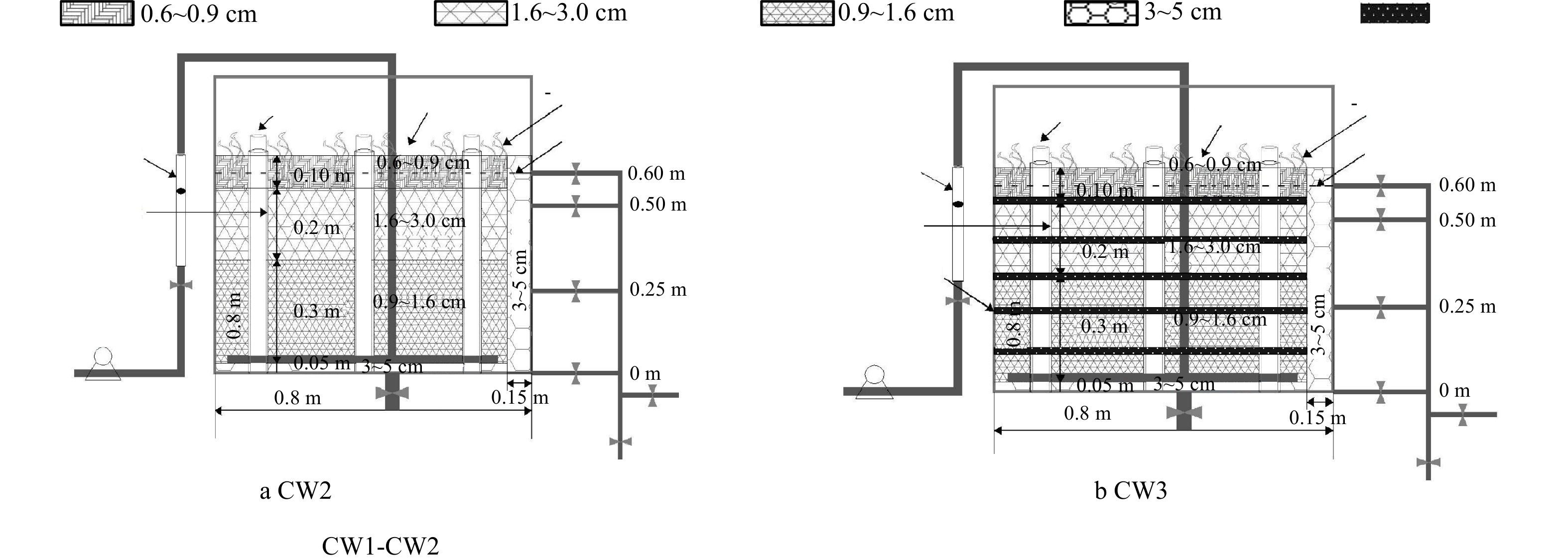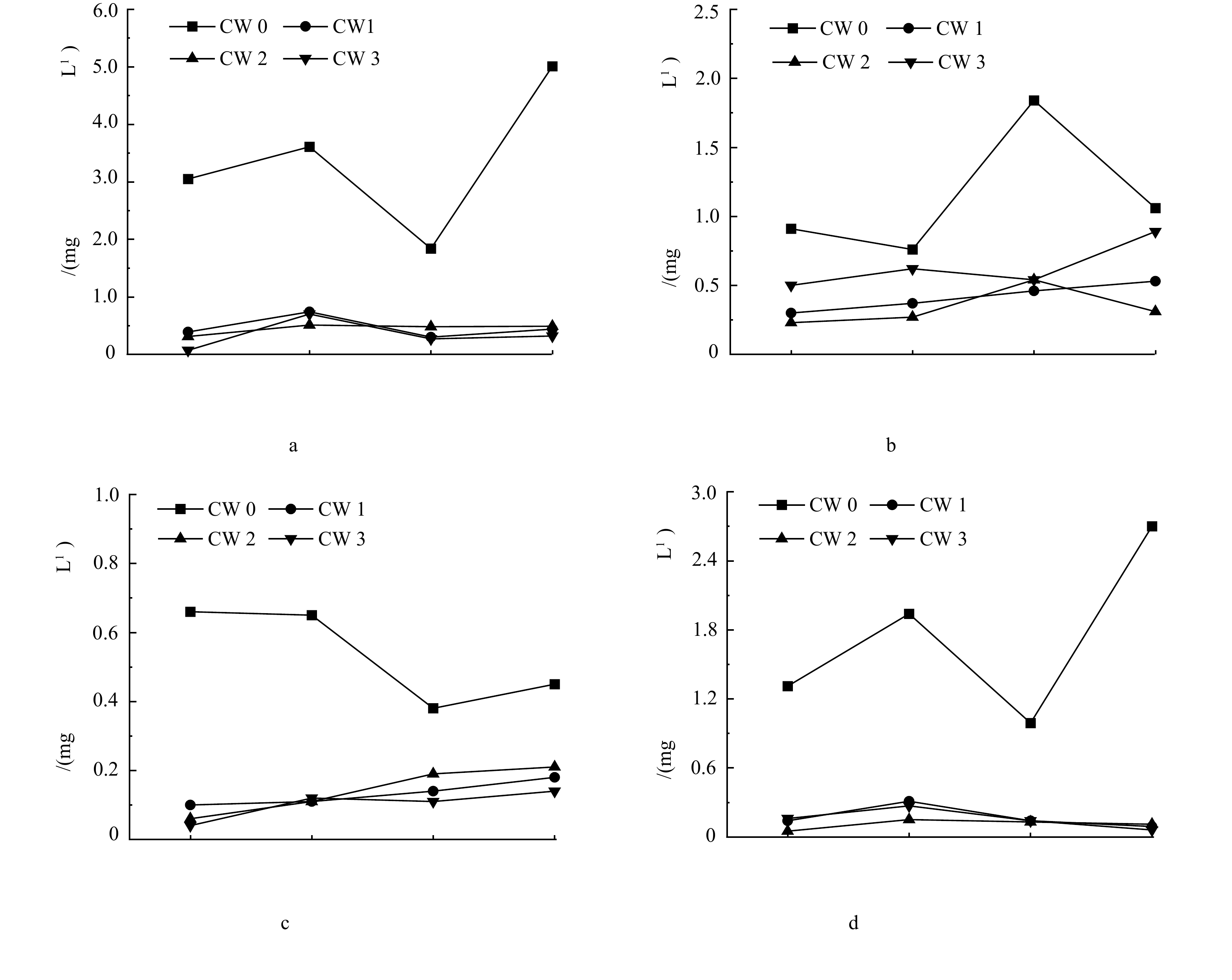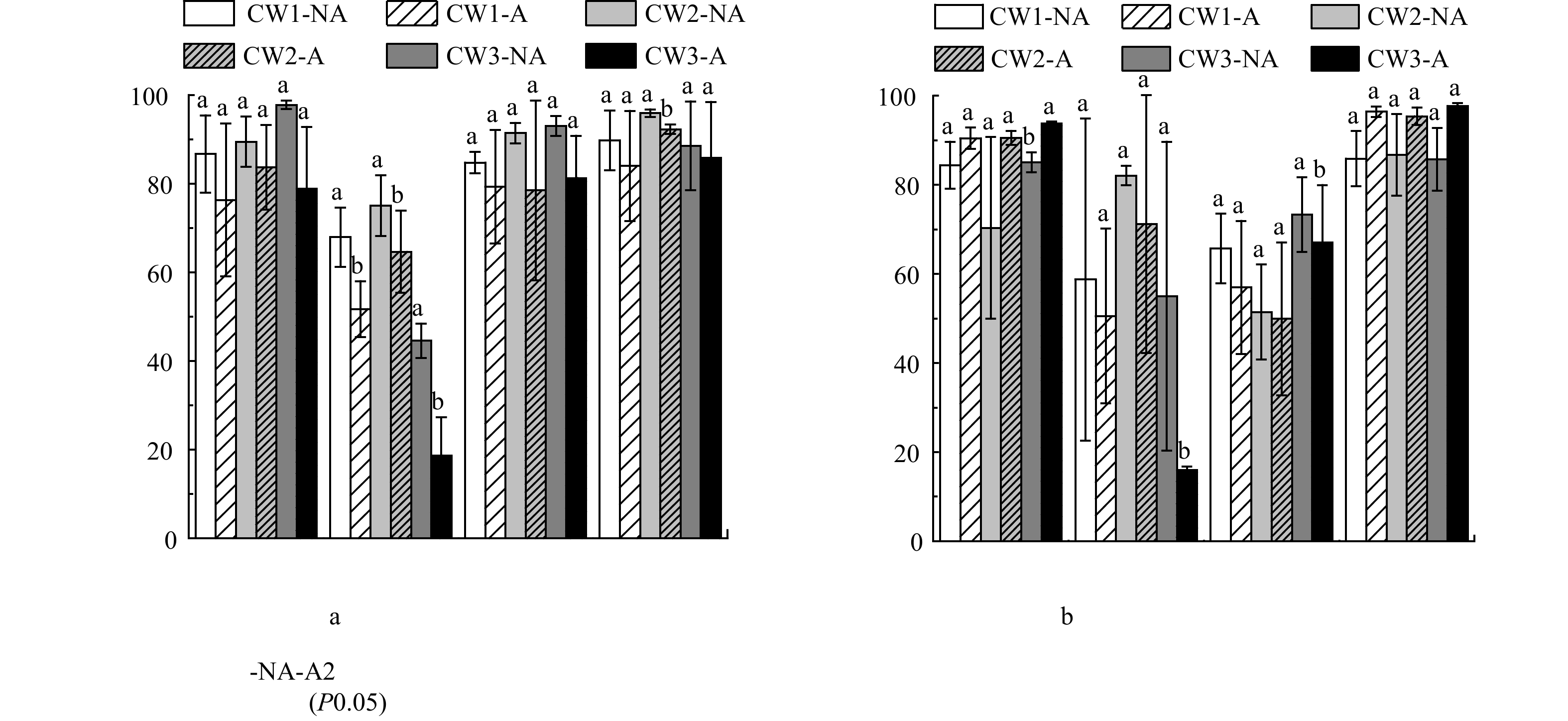-
近年来,我国水产养殖业快速发展,随之带来的环境问题也日益凸显。剩余饵料、养殖对象排泄物等的排放导致尾水中氮磷普遍超标。同时,为了预防和控制疾病,大量的抗生素被广泛应用于水产养殖中[1]。养殖环境中抗生素污染问题已不容忽视,四环素类、喹诺酮类、磺胺类、氯霉素类[2-3]等在养殖尾水或养殖水域中广泛存在。残留在水中的抗生素不仅直接威胁鱼虾的生存,还会加剧环境中耐药菌和耐药基因问题[4]。目前,国家正在大力发展绿色健康养殖业,养殖尾水治理力度不断增加,研发绿色、高效、低成本的抗生素去除技术对于降低抗生素排放、缓解水环境污染具有非常重要的价值。
人工湿地具有处理成本低、操作简单、不会形成二次污染等特点被广泛应用于水产养殖尾水的处理,主要通过基质吸附、微生物降解和植物吸收等过程去除废水中的污染物[5]。然而已有研究表明,不同设计参数与系统结构,如流态、基质类型和组成结构、植物类型与组成结构、水力停留时间和水力负荷、pH和季节因素(如气温、光照等)等均会导致营养盐和抗生素的去除效率存在明显差异[6-7]。同时,抗生素的存在可能会影响人工湿地系统中营养盐的去除。但是,部分研究结果和结论尚不完全一致。有研究表明,废水中抗生素的存在会降低氮磷的去除效率[8]。另一些研究表明,抗生素的存在反而提高氨氮的去除率[9]。此外,也有研究表明,2 mg·L−1的土霉素不会影响人工湿地系统对氮、磷的去除[10]。抗生素的存在对人工湿地系统去除氮磷等营养盐的影响机制尚不清晰,相关研究有待深入探讨。
本研究以3套不同基质和植物条件的上行垂直潜流人工湿地小试系统为研究对象,探究不同季节、不同基质和是否种植耐盐植物海马齿(Sesuvium portulacastrum)情况下,上行垂直潜流人工湿地系统对养殖尾水中4种典型抗生素的去除效果及抗生素的存在是否影响人工湿地系统对营养盐的去除效率。本研究结果有望为进一步改进人工湿地系统设计参数,提高污染物去除效率,促进人工湿地在淡水和海水养殖尾水治理中的应用。
-
本研究构建了3种不同基质或植物条件的垂直潜流人工湿地小试系统(CW1、CW2和CW3),结构示意图如图1所示。系统由圆柱体玻璃钢制成,高80 cm、半径为40 cm,水位控制在60 cm,侧面设置3个不同高度的采样口,本研究统一从最底部采样口采样。系统中种植的植物为多年生且生命力顽强耐干旱的草本盐生植物—海马齿,选取高度在15~20 cm,生长良好的植株移栽至系统中,种植密度为40株·m−2。CW1的基质组成结构为底部铺设5 cm左右的砾石,中下层铺设30 cm高小粒径沸石,中上层铺设20 cm高中粒径沸石,上层铺设10 cm高麦饭石。CW2在CW1的基础上种植海马齿(图1(a))。CW3在CW2的基础上用生物炭层替换相同体积的沸石层(图1(b)),使用2.5 kg生物炭分5层铺设替换共0.05 m3沸石。本实验中使用的生物炭是经过500 ℃高温裂解的玉米秸秆生物炭。
-
实验时间为2021年3月(春季)—2021年6月(夏季)。其中,春季的实验时间为3月10日—4月22日;夏季的实验时间为5月12日—6月25日。受试用的水产养殖尾水均来自福建省淡水水产研究所科研中试基地。本实验选用了养殖水体中常被检出的4种抗生素(氟苯尼考、土霉素、氧氟沙星和磺胺甲恶唑),设计添加质量浓度为250 µg·L−1。春、夏季实验开始前均通过向系统中输入未添加抗生素的养殖尾水进行挂膜,持续20 d。春季实验结束后,通过清水对系统进行清洗,持续20 d。系统采用间歇流(快速进水)运行方式,包括进水-反应-排水-排空闲置4个阶段,每个周期时长为4 d。其中进水时间0.5 h,反应时间为89 h,排水时间为0.5 h,排空闲置6 h。系统每个周期的进水水量约为8 000 L,水力停留时间(HRT)设置为0 (进水)和3 d。春季和夏季,分别采集HRT为0 (进水)和3 d的抗生素和营养盐水样进行分析。
-
待营养盐样品采集完成后,将其装入1 000 mL聚乙烯塑料瓶中,在现场用WTW便携式水质测定仪(Multi 3630)测定水温(T)、电导率(EC)、溶解氧(DO)和pH后,将样品贮存于4 ℃采样箱中,立即带回实验室。用0.45 μm的玻璃纤维滤膜过滤500 mL水样,用于硝态氮(NO3−-N)、氨氮(NH4+-N)的测定,未过滤的水样用于总氮(TN)和总磷(TP)的测定,48 h内完成样品的分析,测定方法参照相关文献[11]。
抗生素水样采集完成后装入100 mL棕色玻璃瓶中并立即运回实验室,用0.22 μm的玻璃纤维滤膜过滤样品,取1 mL注入液相进样小瓶。植物体内抗生素提取方法主要参照陈军[8]并根据多次实验结果进行相应改进。抗生素水样和植物抗生素样品均用高效液相色谱串联质谱仪(LC-MS)测定,其具体参数为:色谱柱为XTERRA MS C18(3.0 mm×100 mm,5 μm)。色谱柱柱温为35 ℃,进样量为5 µL。流动相流速为0.4 mL·min−1,流动相A是体积分数为0.1%的甲酸-水溶液。流动相B为甲醇,洗脱梯度程序设置如下:0~0.5 min,5%B;0.5~3 min,5%~40%B;3~4 min,40%B;4~5 min,40%~95%B;5~7.5 min,95%B;7.5~7.51 min,95%~5%B;7.51~9 min,5%B。
-
本研究应用One-Way ANOVA单因素方差分析研究不同组别去除率总体分布是否有显著性差异;相关统计分析应用SPSS 26软件进行;图件制作应用Origin软件完成;数据预处理采用Excel软件完成。抗生素和营养盐的去除率按照公式(1)计算。
式中:
η为去除率,%;ci 为进水营养盐浓度,mg·L−1和进水抗生素浓度,µg·L−1;ce 为出水营养盐平衡浓度,mg·L−1和抗生素平衡浓度,µg·L−1。 -
春季和夏季进、出水水质状况见表1和表2。总体而言,夏季进、出水平均水温比春季平均水温分别高5.65 ℃和7.20 ℃;夏季进、出水pH平均值比春季分别低0.21和0.26;夏季进、出水电导率平均值比春季分别高5.73 μs·cm−1和7.42 μs·cm−1;夏季进、出水溶解氧平均值比春季分别低0.81 mg·L−1和3.97 mg·L−1。春季和夏季,进水pH均呈弱酸性,经过系统处理后pH呈弱碱性;与进水相比,出水电导率均有所上升,而溶解氧含量下降。
-
春季和夏季,3套系统进、出水中氟苯尼考、土霉素、氧氟沙星和磺胺甲恶唑质量浓度见表3;CW1、CW2和CW3对4种抗生素的去除率见图2。无论春季或夏季,3套系统对土霉素和氧氟沙星的去除率均无明显差异,且均具有良好的去除能力。春季,与CW1相比,CW2对氟苯尼考和磺胺甲恶唑的去除率分别提升了2.71%和1.59%;与CW2相比,CW3对氟苯尼考和磺胺甲恶唑的去除率分别提升了25.34%和45.48%。夏季,与CW1相比,CW2对氟苯尼考和磺胺甲恶唑的去除率分别提升了2.97%和10.16%;与CW2相比,CW3对氟苯尼考和磺胺甲恶唑的平均去除率分别提高19.87%和22.36%。结果表明,种植海马齿可以在一定程度上提升以沸石为主人工湿地系统对氟苯尼考和磺胺甲恶唑的去除效果,添加生物炭可以显著提高(p≤0.05)这两种抗生素的去除率。
人工湿地系统去除抗生素的主要途径包括基质吸附截留、植物吸收、光降解和生物降解等过程,对于垂直潜流人工湿地系统而言,光解作用可以忽略[12]。本研究中3套垂直潜流湿地系统对土霉素和氧氟沙星均有良好的净化效果,而磺胺甲恶唑和氟苯尼考的去除率明显低于土霉素和氧氟沙星,这与其他研究结论一致[13]。土霉素和氧氟沙星分别属于四环素类和氟喹诺酮类抗生素。基质吸附作用是废水中喹诺酮类和四环素类抗生素的主要去除途径[14],一旦暴露在环境中可以快速光解或者被基质吸附,这可能是3套系统均表现出对土霉素和氧氟沙星有良好净化能力的主要原因。氟苯尼考属于甲砜霉素的单氟衍生物,具有氟、氯多个卤代基团和苯环结构,性质较为稳定,不易发生光解和水解,在常规的人工湿地中难以被去除[15]。磺胺甲恶唑属于磺胺类抗生素,在环境中降解速度缓慢,生物降解是磺胺类的抗生素的最主要去除路径[16]。已有研究发现好氧微生物降解、部分厌氧微生物或者兼性厌氧微生物均可促进磺胺甲恶唑降解[17-18]。由于不同研究的进水水质、基质、植物等存在较大差异,系统内微生物群落结构和多样性也不同,磺胺甲恶唑去除率存在较大的差异[19-20]。与一些研究相比[21],本研究中CW1和CW2对磺胺甲恶唑的去除率偏低。这可能是因为水产养殖尾水C/N较低,碳源不足时,不利于磺胺甲恶唑的降解[13]。水体中微生物的种群、数量和活性都与水体中有机质的含量成正相关[22],寡营养态水体中磺胺甲恶唑的降解效率普遍偏低[19]。此外,不同研究中除了植物和基质对抗生素吸收和吸附能力存在差异外,磺胺甲恶唑初始质量浓度的差异,导致其对系统微生物群落结构和多样性的影响也不同,这可能是影响人工湿地系统对其净化能力存在差异的另一重要因素[16]。部分研究也发现,以沸石为主的人工湿地对低浓度的磺胺甲恶唑的去除效果不佳[5,19]。
除夏季土霉素外,植物组(CW2)对4种抗生素的去除率均优于无植物组(CW1)。植物主要通过根系的吸收作用、根际的吸附和截留、根系分泌物和氧气释放增强微生物活性等方式直接或间接去除废水中的抗生素[23]。虽然大部分研究认为植物吸收过程不是人工湿地去除磺胺甲恶唑和氟苯尼考的主要途径,但是适当种植植物可以提高抗生素的去除率[24]。本研究中检测到海马齿中土霉素的质量浓度在851.55~1691.48 µg·L−1,磺胺甲恶唑的质量浓度在125.07~291.67 µg·L−1,表明海马齿能够通过吸收过程移除水体中土霉素和磺胺甲恶唑。结合植物组和无植物组系统对4种抗生素的去除率,说明海马齿对这4种抗生素去除起到一定的促进作用。相比春季,夏季促进效果更明显,可能因为夏季植物生长更旺盛,有利于海马齿对污染物的吸收。
基质是人工湿地的重要组成部分之一,除了对污染物具有吸附作用外,还可为微生物和植物提供基本的生长环境和营养物质[12]。因此,基质的物理化学特征直接影响人工湿地系统对抗生素的净化能力。春季和夏季,添加生物炭均可显著提高垂直潜流人工湿地对氟苯尼考和磺胺甲恶唑的净化能力。相比沸石,生物炭孔隙结构明显、比表面积大,且具有亲水、疏水和酸碱性等性质[25],对抗生素的吸附速度更快,尤其在酸性环境[26]。人工湿地对抗生素的净化能力与基质的类型、组成、微生物群落结构等关系密切,添加生物炭后会改变系统内pH、营养盐和氧气的流动、植物生长状况等,影响系统内其他基质表面的微生物群落结构,进而提升系统对抗生素的净化能力[27]。pH是影响抗生素去除效率的关键因素之一,在酸性条件下磺胺类抗生素以阳离子形式存在。CW3的pH低于CW1和CW2,更有利于生物炭对磺胺甲恶唑和氟苯尼考的吸附。
-
春季和夏季抗生素添加前后3套系统进、出水中总氮、总磷、氨氮和硝态氮的质量浓度见图3。春季,抗生素存在条件下,3种不同条件系统的总氮、总磷、氨氮和硝态氮平均去除率分别下降了11.69%、17.53%、10.04%和4.07%,且3套系统均显著降低了其对总磷的去除效率(P≤0.05)(图4(a))。夏季,抗生素存在条件下,总磷和氨氮的平均去除率分别下降了19.41%和5.53%,而总氮和硝态氮平均去除率分别提高了11.66%和10.42%(图4(b))。
本研究结果表明,春季和夏季抗生素存在对人工湿地去除总氮和硝氮的影响截然不同,而对总磷和氨氮的去除均表现为抑制作用,且在春季3套系统均可以显著降低对总磷的去除效率。其他研究[28]也发现,添加质量浓度为50~100 ng·L−1的氟喹诺酮类抗生素后,TP的去除率下降。基质吸附、植物吸收和聚磷菌(PAOs)的吸收是人工湿地系统中磷的主要去除路径。基质中吸附的土霉素(四环素类)和氧氟沙星(喹诺酮类)可能会与磷争夺吸附位点,导致磷的去除效率下降[9]。抗生素的存在也可能影响聚磷菌的丰度,削弱微生物对磷的吸收过程。YI等[8]发现添加2 mg·L−1的环丙沙星后会降低系统中聚磷菌的丰度,减少细菌对磷的吸收。夏季系统中溶解氧的浓度显著低于春季(表1和表2),厌氧或缺氧条件下,聚磷菌会释放磷,在一定程度上抑制尾水中总磷的去除,这可能是夏季总磷去除率比春季下降更明显的原因之一。
硝化、反硝化、厌氧氨氧化等微生物转化过程是人工湿地系统去除废水中无机氮的主要机制。课题组前期研究发现,抗生素添加前尾水中的细菌群落主要为α-变形菌(α-Proteobacteria)、γ-变形菌(γ-Proteobacteria)、拟杆菌(Bacteroidia)和放线菌(Actinomycete),这些微生物在人工湿地系统去除氮的过程中起着非常关键的作用[29]。好氧条件下,硝化细菌[30](如假单胞菌(Pseudomonas))将系统中NH4+氧化成NO3−的过程是人工湿地系统去除氨氮的重要途径。抗生素的添加可能会影响微生物群落的结构和多样性,从而影响氮的转化过程。YAN等[31]研究发现人工湿地系统中微生物多样性和丰度指数与磺胺甲恶唑、氧氟沙星、罗红霉素等抗生素呈负相关关系,多种抗生素的存在会降低水体中变形菌门(Proteobacteria)的丰度,导致系统对氨氮的去除效率下降,这与本研究的结论一致。夏季,抗生素添加后氨氮去除率下降幅度比春季小,可能因为夏季水温更高,促进微生物硝化作用,提高氨氮去除率,在一定程度上抵消抗生素存在对氨氮去除的不利影响。反硝化过程是指在厌氧条件下,硝酸盐和亚硝酸盐被反硝化细菌异化还原为N2的过程,是系统中硝态氮去除的重要形式。YI等[8]研究发现添加2 mg·L−1的环丙沙星会降低系统对硝态氮的去除。本研究中抗生素添加对硝态氮去除的影响由春季的抑制作用转为夏季的促进作用,可能是因为夏季尾水中溶解氧(<2 mg·L−1)远低于春季(5.09~5.26 mg·L−1),低氧或厌氧条件下有利于拟杆菌和放线菌等反硝化菌群繁殖,促进反硝化过程的发生,提高硝氮的去除效率。硝态氮在进水中占总氮的比重在27.70%~53.89%,是无机氮的主要赋存形态,尤其是夏季,这可能是抗生素添加对总氮和硝态氮去除的影响一致的原因。CHEN等[32]也发现2 mg·L−1的四环素影响了系统内反硝化菌的丰度,系统内硝态氮浓度增加,降低了对总氮的去除率。
在已有的研究中,人工湿地系统基质的组成结构和类型、运行方式、流式、植物类型等不尽相同,且添加的抗生素种类和质量浓度也存在差异,大部分研究结论尚不一致。CHEN[32]等研究发现系统中四环素的质量浓度为2 mg·L−1时不会影响除磷效果,但会降低系统对总氮的去除率;TONG等[33]研究发现添加质量浓度为0.1、10和1 000 µg·L−1氧氟沙星后,人工湿地系统中氨氮的去除率由72.60%提高至80.70%~82.10%;KUYPERS等[34]研究发现在磺胺甲嘧啶质量浓度为100 µg·L−1时,处理组的氨氮去除率略高于对照组。本研究仅考虑4种不同类型抗生素复合对营养盐去除的影响,将来研究中会进一步分析抗生素添加前后微生物群落结构的变化,为阐明本研究试验抗生素添加浓度条件下对营养盐去除影响的机理提供理论依据。
-
1)本研究所构建的3种不同条件垂直潜流人工湿地系统对氧氟沙星和土霉素在春季和夏季均表现出良好的去除效果,去除率均在85%以上。与氧氟沙星和土霉素相比,系统对磺胺甲恶唑和氟苯尼考的去除效率相对较低,春季,系统对氟苯尼考和磺胺甲恶唑的去除率分别为17.23%~67.50%和8.37%~67.87%;夏季,系统对氟苯尼考和磺胺甲恶唑的去除率分别为12.01%~41.29%和19.28%~67.04%。
2)春季和夏季,种植海马齿整体上可以提高系统对4种抗生素的去除效率,但均不具有显著性差异;春季和夏季,添加生物炭均可提高系统对4种抗生素的去除效率,且会显著提高系统对磺胺甲恶唑和氟苯尼考的去除效率。
3)无论是春季还是夏季,4种抗生素添加均对总磷和氨氮的去除产生一定的负面影响,但不同季节对总氮和硝态氮去除效率的影响存在差异。在抗生素存在的条件下,春季,3种不同条件的人工湿地系统对总氮、总磷、氨氮和硝态氮平均去除率分别下降了11.69%、17.53%、10.04%和4.07%;夏季,总磷和氨氮的平均去除率分别下降了19.41%和5.53%,而总氮和硝态氮的平均去除率分别提高了11.67%和10.42%。
垂直潜流人工湿地对水产养殖尾水中抗生素和氮磷的去除及其影响因素
Analysis of influence factors on antibiotics and nutrients removal from aquaculture wastewater by vertical flow constructed wetlands
-
摘要: 针对养殖尾水中氮磷和抗生素污染问题,构建了3种不同条件的上行垂直潜流人工湿地小试系统,分析了养殖尾水中4种典型抗生素(氧氟沙星、磺胺甲恶唑、氟苯尼考和土霉素)的去除效率及其影响因素,探讨了抗生素对营养盐去除的潜在影响。结果表明:在春季和夏季,3种不同条件的上行垂直潜流人工湿地系统对氟苯尼考、土霉素、氧氟沙星和磺胺甲恶唑的去除率分别为25.61%~53.66%和15.10%~37.93%、94.82%~97.16%和93.96%~94.87%、93.53%~94.27%和85.17%~86.57%、10.48%~57.54%和29.84%~62.36%。添加生物炭可以显著提高湿地系统对磺胺甲恶唑和氟苯尼考的去除率,与CW1和CW2相比,CW3对磺胺甲恶唑的去除率平均分别提高了39.79%和33.92%;对氟苯尼考的去除率平均分别提高了25.45%和22.61%。在抗生素暴露条件下,春季,系统对总氮、总磷、氨氮和硝态氮平均去除率分别下降了11.69%、17.53%、10.04%和4.07%;夏季,总磷和氨氮的平均去除率分别下降了19.41%和5.53%,而总氮和硝态氮的平均去除率分别提高了11.67%和10.42%。以上研究结果可为进一步改进人工湿地系统设计参数,提高污染物去除效率提供参考依据。Abstract: Constructed wetlands (CWs) are widely used for removal of pollutants in aquaculture wastewater due to its advantages of efficient, economical and environment-friendly features. Aiming at the problems of antibiotics and nutrients pollution in aquaculture wastewater, three test-batch vertical flow constructed wetlands (VFCW) with different substrates or plant conditions were constructed to investigate the factors affecting the removal of four typical antibiotics and nutrients from aquaculture wastewater, then the potential effect of antibiotics on the nutrient removal was further studied. The results showed that the removal rates of florfenicol, oxytetracycline, ofloxacin and sulfamethoxazole were 25.61%~53.66%, 94.82%~97.16%, 93.53%~94.27% and 10.48%~57.54% in spring, then 15.10%~37.93%, 93.96%~94.87%, 85.17%~86.57% and 29.84%~62.36% in summer, respectively. Addition of biochar as substrate could significantly increase the removal rates of sulfamethoxazole and florfenicol by VFCW. Compared with CW1 (VFCW with no biochar and plant) and CW2 (VFCW with no biochar), the average increase ratios of sulfamethoxazole removal rate by CW3 (VFCW with biochar and plant) were 39.79% and 33.92%, respectively; the average increase ratios of florfenicol were 25.45% and 22.61%, respectively. In spring, after 3 days- exposure to 4 antibiotics, the average removal rates of TN, TP, NH4+-N, and NO3--N in the system decreased by 11.69%, 17.53%, 10.04%, and 4.07%, respectively. In summer, the average removal rates of TP and NH4+-N in the system decreased by 19.41% and 5.53%, respectively, while the average removal rates of TN and NO3--N increased by 11.67% and 10.42%, respectively. This is expected to provide a reference for further improving the design parameters of constructed wetland system and increasing the removal efficiency of pollutants.
-
Key words:
- aquaculture wastewater /
- vertical flow constructed wetlands /
- antibiotic /
- nutrients
-
表 1 春季无抗生素和抗生素存在条件下进、出水水质状况
Table 1. Characteristics of inlet and outlet water before and after antibiotic exposure in spring
实验条件 系统 温度/ ℃ pH 电导率/(μs·cm−1) 溶解氧/(mg·L−1) 无抗生素 CW0 21.33±0.79 6.88±0.12 69.33±9.60 7.25±0.93 CW1 22.30±0.37 7.87±0.05 136.2±9.43 5.40±0.93 CW2 22.53±0.33 7.75±0.02 141.7±9.80 5.32±0.26 CW3 22.43±0.37 7.71±0.06 154.0±11.0 5.56±0.78 有抗生素 CW0 26.63±1.78 6.82±0.07 53.50±3.21 7.25±0.27 CW1 26.70±2.24 7.90±0.17 124.8±1.32 5.21±0.25 CW2 26.90±2.30 7.77±0.12 132.43±3.74 5.09±0.32 CW3 26.83±2.24 7.77±0.10 142.13±3.56 5.26±0.38 注:CW0为进水。 表 2 夏季无抗生素和抗生素存在条件下进、出水水质状况
Table 2. Characteristics of inlet and outlet water before and after antibiotic exposure in summer
实验条件 系统 温度/ ℃ pH 电导率/(μs·cm−1) 溶解氧/(mg·L−1) 无抗生素 CW0 29.63±0.85 6.89±0.10 57.93±0.37 6.28±0.34 CW1 29.40±0.65 7.84±0.10 129.47±5.20 1.44±0.01 CW2 29.57±0.74 7.69±0.10 140.83±7.24 1.15±0.07 CW3 29.70±0.86 7.64±0.10 151.33±8.01 1.28±0.04 有抗生素 CW0 29.33±0.86 6.29±0.06 83.37±11.64 6.60±0.61 CW1 28.60±1.23 7.52±0.10 142.47±7.90 1.27±0.08 CW2 28.87±1.35 7.46±0.07 149.30±7.68 1.36±0.20 CW3 28.80±1.31 7.38±0.08 162.43±2.80 1.54±0.12 注:CW0为进水。 表 3 春季和夏季3套系统进、出水中抗生素的质量浓度
Table 3. Antibiotics concentrations in the inlet and outlet water of three systems in spring and summer μg·L-1
季节 系统 氟苯尼考 土霉素 氧氟沙星 磺胺甲恶唑 春季 CW0 257.5±20.85 237.03±15.36 309.91±15.38 271.16±9.38 CW1 193.11±36.01 12.35±0.23 20.42±2.11 244.92±11.88 CW2 186.12±37.31 8.14±5.77 19.00±2.34 243.29±8.73 CW3 120.41±25.50 10.47±1.03 18.10±2.05 136.45±38.87 夏季 CW0 238.78±8.09 250.04±19.43 255.80±16.31 250.33±10.00 CW1 202.65±6.14 14.87±4.92 37.84±7.97 175.76±13.73 CW2 195.48±1.34 15.34±4.41 36.29±9.84 150.50±13.55 CW3 148.00±2.86 13.12±5.14 34.31±8.88 94.58±14.43 注:CW0为进水。 -
[1] CAO L, WANG W, YANG Y, et al. Environmental impact of aquaculture and countermeasures to aquaculture pollution in China[J]. Environmental Science and Pollution Research-International, 2007, 14(7): 452-62. doi: 10.1065/espr2007.05.426 [2] HAN Q F, ZHAO S, ZHANG X R, et al. Distribution, combined pollution and risk assessment of antibiotics in typical marine aquaculture farms surrounding the Yellow Sea, North China[J]. Environment International, 2020, 138: 105551. doi: 10.1016/j.envint.2020.105551 [3] CHEN C Q, ZHENG L, ZHOU J L, et al. Persistence and risk of antibiotic residues and antibiotic resistance genes in major mariculture sites in Southeast China[J]. Science of the Total Environment, 2017, 580: 1175-1184. doi: 10.1016/j.scitotenv.2016.12.075 [4] YUAN L, WANG L, LI Z, et al. Antibiotic resistance and microbiota in the gut of Chinese four major freshwater carp from retail markets[J]. Environmental Pollution, 2019, 255: 113327. doi: 10.1016/j.envpol.2019.113327 [5] 陈军. 生活污水中抗生素和耐药基因的人工湿地去除机制与系统优化[D]. 广州: 中国科学院大学, 2017. [6] 李飞翔, 岳琛, 张超月, 等. 人工湿地去除水产养殖尾水中氮磷的影响因素识别[J]. 生态与农村环境学报, 2022, 38(7): 8. [7] ZHENG Y, LIU Y, QU M, et al. Fate of an antibiotic and its effects on nitrogen transformation functional bacteria in integrated vertical flow constructed wetlands[J]. Chemical Engineering Journal, 2021(11): 129272. [8] YI K, D WANG, QI YANG, et al. Effect of ciprofloxacin on biological nitrogen and phosphorus removal from wastewater[J]. Science of the Total Environment, 2017, 605: 368. [9] 覃岚倩, 白少元, 张琴, 等. 人工湿地对抗生素复合污染的净化效果及微生物群落响应[J]. 生态学杂志, 2021, 40(2): 525-533. doi: 10.13292/j.1000-4890.202102.006 [10] SANTOS F, ALMEIDA C, RIBEIRO I, et al. Potential of constructed wetland for the removal of antibiotics and antibiotic resistant bacteria from livestock wastewater[J]. Ecological Engineering, 2019, 129: 45-53. doi: 10.1016/j.ecoleng.2019.01.007 [11] 《水和废水监测分析方法》编委会. 水和废水监测分析方法[M]. 北京: 中国环境科学出版社, 1989. [12] WU H, ZHANG J, NGO H H, et al. A review on the sustainability of constructed wetlands for wastewater treatment: Design and operation[J]. Bioresource Technology, 2015, 175: 594-601. doi: 10.1016/j.biortech.2014.10.068 [13] YUAN Y, YANG B, WANG H, et al. The simultaneous antibiotics and nitrogen removal in vertical flow constructed wetlands: Effects of substrates and responses of microbial functions[J]. Bioresource Technology, 2020, 310: 123419. doi: 10.1016/j.biortech.2020.123419 [14] ZHU T, SU Z, LAI W, et al. Insights into the fate and removal of antibiotics and antibiotic resistance genes using biological wastewater treatment technology[J]. Science of The Total Environment, 2021, 776: 145906. doi: 10.1016/j.scitotenv.2021.145906 [15] 刘佳, 易乃康, 熊永姣, 等. 人工湿地构型对水产养殖废水含氮污染物和抗生素去除影响[J]. 环境科学, 2016, 37(9): 3430-3437. doi: 10.13227/j.hjkx.2016.09.022 [16] 崔迪, 邓红娜, 庞长泷, 等. 生物法去除水环境中磺胺甲恶唑的研究进展[J]. 中国给水排水, 2019, 35(24): 7. doi: 10.19853/j.zgjsps.1000-4602.2019.24.007 [17] VASILIADOU I A, MOLINA R, F MARTÍNEZ, et al. Biological removal of pharmaceutical and personal care products by a mixed microbial culture: Sorption, desorption and biodegradation[J]. Biochemical Engineering Journal, 2013, 81(Complete): 108-119. [18] REIS AC, ČVANČAROVÁ M, LIU Y, et al. Biodegradation of sulfamethoxazole by a bacterial consortium of Achromobacter denitrificans PR1 and Leucobacter sp[J]. GP. Applied Microbiology and Biotechnology, 2018, 102(23): 10299-10314. doi: 10.1007/s00253-018-9411-9 [19] DAN A, YANG Y, DAI Y N, et al. Removal and factors influencing removal of sulfonamides and trimethoprim from domestic sewage in constructed wetlands[J]. Bioresource Technology, 2013, 146: 363-370. doi: 10.1016/j.biortech.2013.07.050 [20] SONG H L, ZHANG S, GUO J H, et al. Vertical up-flow constructed wetlands exhibited efficient antibiotic removal but induced antibiotic resistance genes in effluent[J]. Chemosphere, 2018, 203(1): 434-441. [21] DAI M, ZHANG Y, WU Y, et al. Mechanism involved in the treatment of sulfamethoxazole in wastewater using a constructed wetland microbial fuel cell system[J]. Journal of Environmental Chemical Engineering, 2021, 9(5): 106193. doi: 10.1016/j.jece.2021.106193 [22] GUO M J, CAO J, WANG C Y, et al. Microbial biomass and nutrients in soil at different stages of secondary forest succession in Ziwulin, North-west China[J]. Forest Ecology and Management, 2005, 217: 117-125. doi: 10.1016/j.foreco.2005.05.055 [23] KUMAR S, DUTTA V. Constructed wetland microcosms as sustainable technology for domestic wastewater treatment: an overview[J]. Environmental Science and Pollution Research-International, 2019, 26(12): 11662-11673. doi: 10.1007/s11356-019-04816-9 [24] WEI W, TONG J, HU B. X. Study on ecological dynamic model for phytoremediation of farmland drainage water[J]. Journal of Hydrology, 2019, 578: 124026. doi: 10.1016/j.jhydrol.2019.124026 [25] 李泽兵, 韩飞, 曾圣男, 等. 人工湿地去除养殖废水中磺胺类抗生素的影响因素研究进展[J]. 生态毒理学报, 2020, 15(5): 49-58. [26] PEIRIS C, GUNATILAKE S. R, MLSNA T. E, et al. Biochar based removal of antibiotic sulfonamides and tetracyclines in aquatic environments: A critical review[J]. Bioresource Technology, 2017, 246: 150-159. doi: 10.1016/j.biortech.2017.07.150 [27] DENG S, CHEN J, CHANG J. Application of biochar as an innovative substrate in constructed wetlands/biofilters for wastewater treatment: Performance and ecological benefits[J]. Journal of Cleaner Production, 2021, 293: 126156. doi: 10.1016/j.jclepro.2021.126156 [28] LI X, LU S, LIU S, et al. Shifts of bacterial community and molecular ecological network at the presence of fluoroquinolones in a constructed wetland system[J]. Science of the Total Environment, 2020, 708: 135156. doi: 10.1016/j.scitotenv.2019.135156 [29] 王飞鹏, 黄亚玲, 张瑞瑞, 等. 不同曝气方式对人工湿地细菌多样性, 代谢活性及功能的影响[J]. 环境科学, 2022, 43(4): 2007-2017. [30] LU S Y, ZHANG Y R, LIU X H, et al. Effects of sulfamethoxazole on nitrogen removal and molecular ecological network in integrated vertical-flow constructed wetland[J]. Ecotoxicology and Environmental Safety, 2021, 219: 112292. doi: 10.1016/j.ecoenv.2021.112292 [31] YAN Q, MIN J, YU Y, et al. Microbial community response during the treatment of pharmaceutically active compounds (Ph ACs) in constructed wetland mesocosms[J]. Chemosphere, 2017, 186: 823-831. doi: 10.1016/j.chemosphere.2017.08.064 [32] CHEN A, CHEN B, DING C. Effects of tetracycline on simultaneous biological wastewater nitrogen and phosphorus removal[J]. Rsc Advance, 2015, 5(73): 59326-59334. doi: 10.1039/C5RA08434B [33] TONG X, WANG X, HE X, et al. Effects of ofloxacin on nitrogen removal and microbial community structure in constructed wetland[J]. Science of the Total Environment, 2019, 656: 503-511. doi: 10.1016/j.scitotenv.2018.11.358 [34] KUYPERS M, MARCHANT H K, KARTAL B. The microbial nitrogen-cycling network[J]. Nature Reviews Microbiology, 2018, 16(5): 263-276. doi: 10.1038/nrmicro.2018.9 -





 下载:
下载:






